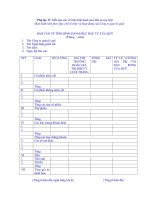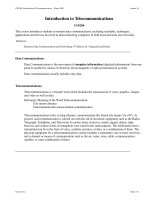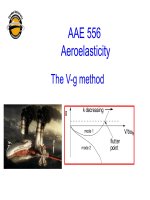AAE556 lecture 17 Typical section vibration
Bạn đang xem bản rút gọn của tài liệu. Xem và tải ngay bản đầy đủ của tài liệu tại đây (255.15 KB, 16 trang )
AAE 556
Aeroelasticity
Lecture 17
Typical section vibration
Purdue Aeroelasticity
17-1
Understanding the origins of flutter
Typical section equations of motion - 2 DOF
x
Plunge displacement h is positive
downward & measured at the
restrict to small angle
h(t)
θ(t)
c.g.
shear center
shear
center
xcg
xθ
h ( t ) = plunge freedom (bending )
θ ( t ) = pitch freedom ( twist )
measured at the shear center from static equilibrium position
17-2
Purdue Aeroelasticity
A peek ahead at the final result
coupled equations of motion
dynamically coupled but elastically uncoupled
m
mx
θ
&
mxθ h&
Kh
+
&
Iθ θ&
0
0 h
0
=
KT θ
0
x
mg = weight
restrict to small angle
h(t)
θ(t)
c.g.
shear
center
xcg
xθ
xθ is called static unbalance and is the source of dynamic coupling
17-3
Purdue Aeroelasticity
Lagrange and analytical dynamics
an alternative to FBD’s and Isaac Newton
z(t) is the downward displacement of a small
portion of the airfoil at a position x located
downstream of the shear center
d ∂ (T − U ) ∂ (T − U )
= Qi
÷−
dt ∂η&i
∂ηi
z = h + x sin θ ≅ h + xθ
x
kinetic energy
restrict to small angle
h(t)
θ(t)
c.g.
1 x = xt
T = ∫
( ρ )(h&+ xθ&) 2 dx
2 x =− xl
shear
center
strain energy
xcg
1
1
2
U = K h h + KT θ 2
2
2
17-4
Purdue Aeroelasticity
Expanding the kinetic energy integral
(
)
x = xt
1 x = xt
2
&
&
T = ∫
( ρ )(h + xθ ) dx = ∫
ρ h&2 + 2 ρ xh&
θ&+ ρ x 2θ&2 dx
x =− xl
2 x =− xl
m = ∫ ρ ( x )dx
m is the total mass
Sθ = mxθ = ∫ ρ ( x ) xdx
Sq is called the static unbalance
Iθ = ∫ ρ x 2 dx = I o + mxθ2
Iq is called the airfoil mass moment of inertia – it has 2 parts
1 &2
2
&
&
&
T =
(mh + 2Sθ hθ + Iθ θ )
2
17-5
Purdue Aeroelasticity
Equations of motion for the unforced system (Qi = 0)
∂T
= mh + mxθ θ
∂h
∂T
+ I θ
=
mx
h
θ
θ
∂θ
∂U
= Khh
∂h
∂U
= KT θ
∂θ
EOM in matrix form, as promised
m
mx
θ
&
mxθ h&
Kh
+
&
Iθ θ&
0
0 h
0
=
KT θ
0
17-6
Purdue Aeroelasticity
Differential equation
a trial solution
Goal – frequencies and mode shapes
h st
h(t )
= e
θ (t )
θ
Substitute this into differential equations
m
s
mxθ
2
mxθ h st K h
e +
Iθ θ
0
0 h st
0
e =
K h θ
0
17-7
Purdue Aeroelasticity
There is a characteristic equation here
m
s
mxθ
2
mxθ h st K h
e +
Iθ θ
0
( s 2 m + K h )
( s 2 mxθ )
0 h st
0
e =
K h θ
0
2
s
( mxθ ) h st 0
e =
2
s
( Iθ + K h ) θ 0
17-8
Purdue Aeroelasticity
The time dependence term is factored out
2
2
(s m + K h )
2
( s mxθ )
( s mxθ )
2
( s Iθ + KT )
Determinant of dynamic system matrix
set determinant to zero (characteristic equation)
( s m+K ) ( s I
2
2
h
θ
+ KT ) − ( s mxθ ) ( s mxθ ) = 0
2
2
17-9
Purdue Aeroelasticity
Nondimensionalize by dividing by m and Iθ
( )
2
mx
2 K h 2 KT
− s 2 s 2 θ = 0
s +
s +
m
Iθ
I
θ
Define uncoupled frequency parameters
ω h2
(s
2
Kh
=
m
+ ω h2
)(
ωθ2
KT
=
Iθ
) ( )
2
mx
s 2 + ωθ2 − s 2 s 2 θ = 0
I
θ
4 mxθ2 2 2
2
2 2
=
0
s 1 −
÷+ s ( ω h + ωθ ) + ω h ωθ ÷
÷
I
θ
17-10
Purdue Aeroelasticity
Solution for natural frequencies
(
)
4 Io 2 2
2
2
2
s + s ω h + ωθ + ω h ωθ = 0
I
θ
(as
4
)
2
+ bs + c = 0
2
− b ± b − 4ac
s =
2a
2
17-11
Purdue Aeroelasticity
Solutions for exponent s
These are complex numbers
−
s2 =
(
ω h2
+ ωθ2
)± (
ω h2
)
2 2
+ ωθ
Io 2 2
− 4 ω h ωθ
Iθ
Io
2
Iθ
2
1 Iθ
Iθ 2 2
1 Iθ 2
2
2
2
s = − ÷( ω h + ωθ ) ±
ω h + ωθ ) − ÷ω h ωθ
(
2 Io
2 Io
Io
2
e =e
st
± iωt
17-12
Purdue Aeroelasticity
solutions for s are complex numbers
Iθ =
2
mrθ
Iθ
=
Io
Io =
and
2
I o + mxθ
2
mro
=
Iθ
= 1+
Io
2
mro
2
mro
2
+ mxθ
2
mro
2
xθ
2
ro
17-13
Purdue Aeroelasticity
Example configuration
2b=c
xθ = 0.10c = 0.20b
and
xθ
= 0.40
ro
xθ
1 +
ro
2
= 1.16
ro = 0.25c = 0.5b
and
xθ = aro
xθ
ro
2
= 0.16
Iθ
2
= 1+ a
Io
New terms – the radius of gyration
17-14
Purdue Aeroelasticity
Natural frequencies change when the wing c.g. or EA positions change
2
1 Iθ
Iθ 2 2
1 Iθ 2
2
2
2
2
ω = + ÷( ω h + ωθ ) − or +
ω h + ωθ ) − ÷ω h ωθ
(
2 Io
2 Io
Io
2
= 1 + a 2
x
restrict to small angle
h(t)
θ(t)
shear
center
xcg
c.g.
40
35
natural frequencies
(rad./sec.)
x
Iθ
= 1 + θ
Io
ro
Natural frequencies
vs.
c.g. offset
30
torsion frequency
25
20
fundamental
(plunge) frequency
15
10
5
0
0.00
0.25
0.50
0.75
c.g. offset
c.g. offset in semi-chords
17-15
Purdue Aeroelasticity
1.00
Summary?
17-16
Purdue Aeroelasticity









